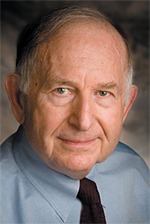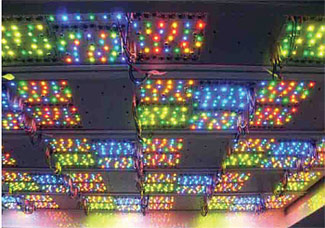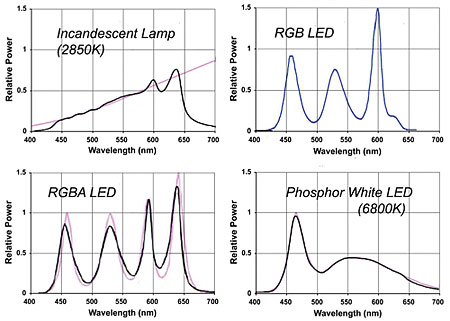Developing Standards In Lighting

How about this for an idea? Suppose I had a room in which I was able to create upon demand the spectral response of many light-source types. The environment of this special room would be able to simulate the color spectrum of a black-body radiator, then change to an incandescent lamp operating at 3,200 Kelvin, or to a "white" LED or an RGBA LED source.
To make the comparison even more dramatic, suppose that there are two separately adjustable rooms. Well, believe it or not, this has been done by the Optical Technology Division of the National Institute of Standards and Technology (NIST).
They call it the "Spectrally Tunable Lighting Facility," or, if you will, the STLF of the NIST.
The NIST is a governmental agency, part of the Department of Commerce. At one time it was called the National Bureau of Standards. NIST is involved in establishing accurate and stable standards for an enormous range of disciplines to aid U.S. commerce.
In the early 1800s, it was known as the Office of Standard Weights and Measures. But through the years, it has operated way beyond the scope of simple weights and measures, establishing thousands of standards for quality, safety, performance and precision maintenance in a myriad number of industries.

A NIST STLF room To illustrate the diversity of these industries, the list includes research in the fields of nuclear physics, health care, DNA, computer encryption, and even ballistic body armor (to name a few). In addition, and of particular interest to us in entertainment lighting, the Optical Sensor Group of its Physics Laboratory is currently engaged in research on the measurement of LED sources for use in lighting.
Because of the group's rigorous scientific approach, it is expected that the results of its research will be of great value in removing the cloak of mystery that surrounds the performance of solid-state lighting devices.
COLOR QUALITY SCALE
NIST's Optical Sensor Group is currently developing a new Color Quality Scale (CQS) to replace the Color Rendering Index (CRI) in use today. This new measurement standard is designed to correct all the shortcomings of the CRI that became particularly evident when applied to LED lighting sources.
The Color Rendering Index is supposed to provide a convenient indication of the spectral characteristics of a source by evaluating its ability to reproduce colors. Although 15 colors are in the original test sample, only 8 specific colors are actually used (for some obtuse reason). This "sample" choice of colors is not particularly comprehensive.
As an illustration, none are very saturated. The CRI is based upon a scale of 0 to 100, an index of 100 being "perfect" reproduction of the colors (or "this is as good as it gets") as compared to the spectra of theoretical Planckian Black-Body Source operating at a specific Color Temperature.
The response of the eye of the standard "observer," a person statistically determined to represent the norm, circa 1931, is also included as part of the calculation of the CRI.
Common usage of the Index says that a CRI of greater than 85 is a "very acceptable" light source to reproduce all colors of the visible spectrum. The LED, however, with its noncontinuous spectrum is a dilemma; determination of the Color Rendering Index for these sources can result in a very misleading conclusion.

Ceiling Fixture LEDs (Diffuser Removed) To alleviate this problem, NIST has proposed this new method and index: the "Color Quality Scale." The range of colors is 15, and includes saturated as well as less-saturated hues. Not only that, the colors are identified by the Munsell Color System designation, a very accepted, reliable and comprehensive color scheme.
The new CQS index also features correction for a number of other errors that are included to make the index more precise. One particular consideration is the human eye's adaptation to the spectral characteristics of the source—the fact that the eye attempts to make the colors appear correct.
It is hoped that the effects of the research of the NIST scientists and the acceptance by the lighting-fixture manufacturers will provide us with a better and more accurate manner in which to judge the color spectrum of light sources (particularly when they are solid-state light devices).
BACK TO THE LAB
The details of the NIST "Tunable Lighting Facility" that started this discussion are really interesting. As part of its investigation of LED light sources, NIST built two small rooms about eight-foot square with a standard ceiling height.
Mounted in the ceiling of each of the rooms is the lighting "fixture." Within this fixture are 22 color channels of LEDs, each with a peak output over the range of the visible spectrum. The population of each channel is such that each channel produces the same order of magnitude of light power. To accomplish this, there are a total of 1,800 LEDS in each space acting as the room's fixture!

Examples of Simulated Sources Spectral Output Another interesting detail: For wavelengths in the visible spectrum where narrow-band LEDs producing these wavelengths do not exist, NIST cleverly used broad-band LED units to fill these gaps. However, as additional narrow-band LEDs are available, the system is designed to be extended past its present limits.
THE RESULT
The end result is that with the room's control system NIST can simulate the color spectrum of any type RGB or RGBA LED configuration—as well as the phosphor "white" LED sources. As a control, NIST can also simulate the continuous spectrum of black-body sources at any specific color temperature from 2,500 K to 10,000 K by the predetermined selection of LED sources in the room's fixture.
The approximate amount of incident light in the room under test conditions is about 50 foot-candles—typical of a well-lighted office. Unfortunately, it is not possible to obtain a simulation of discharge sources as an HMI or fluorescent lamp because of the magnitude of the narrow bandwidth of the "spikes" of light power that discharge lamps produce. Shown in the enclosed graphs are some illustrations of the spectral output obtained from simulations of an incandescent lamp at 2,850 K, and some specific LED sources.
THE QCS FUTURE
This introduction to the studies of the National Institute of Standards and Technology is to make the reader aware of work that will greatly benefit our ability to evaluate the performance of solid-state lighting sources as they evolve. It is my opinion that the Quality Color Scale represents a great start.
Bill Klages would like to extend an invitation to all the lighting people out there to give him your thoughts atbillklages@roadrunner.com.
The professional video industry's #1 source for news, trends and product and tech information. Sign up below.
